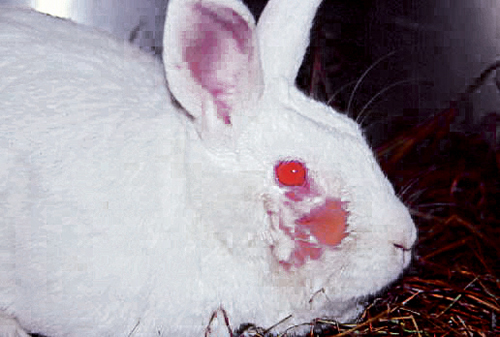Difference between revisions of "Rabbit Medicine and Surgery Q&A 06"
Ggaitskell (talk | contribs) (Created page with "{{Template:Manson Keeble Meredith}} centre|500px <br /> '''This rabbit is displaying what is often the earliest sign of acquired dental diseas...") |
|||
| Line 18: | Line 18: | ||
*Secondary bacterial infection of the duct often follows (dacryocystitis), where milky fluid can be expressed from the lacrimal sac by gentle pressure below the medial canthus. | *Secondary bacterial infection of the duct often follows (dacryocystitis), where milky fluid can be expressed from the lacrimal sac by gentle pressure below the medial canthus. | ||
*In more advanced dental disease, root elongation or a periapical abscess of the first maxillary premolar may also block the duct. | *In more advanced dental disease, root elongation or a periapical abscess of the first maxillary premolar may also block the duct. | ||
| − | |l1= | + | |l1=Cheek Teeth Malocclusion – Rabbit |
|q2=What other indicators of dental disease might be apparent on routine physical examination, even before inspecting the oral cavity? | |q2=What other indicators of dental disease might be apparent on routine physical examination, even before inspecting the oral cavity? | ||
|a2= | |a2= | ||
| Line 30: | Line 30: | ||
The rabbit may be currently anorexic (perhaps with gut stasis) and reluctant to drink from a dropper bottle, or the owner may report a history of periods of anorexia as a succession of lesions heal, only to reform once mastication resumes. This is reflected in a gradual net loss of body condition.<br><br> | The rabbit may be currently anorexic (perhaps with gut stasis) and reluctant to drink from a dropper bottle, or the owner may report a history of periods of anorexia as a succession of lesions heal, only to reform once mastication resumes. This is reflected in a gradual net loss of body condition.<br><br> | ||
Buccal lesions may become infected and give rise to facial abscesses. Continued retrograde tooth elongation eventually results in perforation of the periosteum and extension of periodontal infection to form periapical abscesses. Those arising from maxillary cheek teeth may be associated with exophthalmus (molars), intrusion into the nasal passages, causing rhinitis and respiratory noise (PM1), or swelling below the medial canthus (PM2, PM3). | Buccal lesions may become infected and give rise to facial abscesses. Continued retrograde tooth elongation eventually results in perforation of the periosteum and extension of periodontal infection to form periapical abscesses. Those arising from maxillary cheek teeth may be associated with exophthalmus (molars), intrusion into the nasal passages, causing rhinitis and respiratory noise (PM1), or swelling below the medial canthus (PM2, PM3). | ||
| − | |l2= | + | |l2=Cheek Teeth Malocclusion – Rabbit#Clinical Signs |
</FlashCard> | </FlashCard> | ||
Revision as of 09:51, 11 August 2011
| This question was provided by Manson Publishing as part of the OVAL Project. See more Rabbit Medicine and Surgery questions |
This rabbit is displaying what is often the earliest sign of acquired dental disease.
| Question | Answer | Article | |
| What is the condition, and how is it related to the teeth? | The rabbit has epiphora, which has caused a secondary superficial pyoderma and local alopecia below the eye.
|
Link to Article | |
| What other indicators of dental disease might be apparent on routine physical examination, even before inspecting the oral cavity? |
The pain associated with these lesions stimulates salivation and interferes with swallowing, resulting in ptyalism. This is seen as a wet or matted chin, brisket or forelimbs, perhaps with secondary dermatitis. |
Link to Article | |
